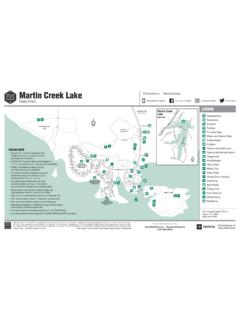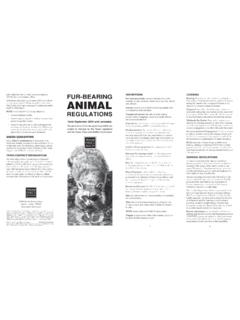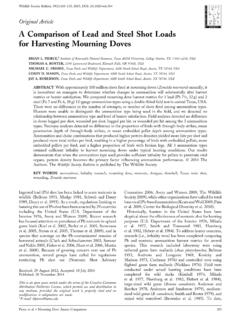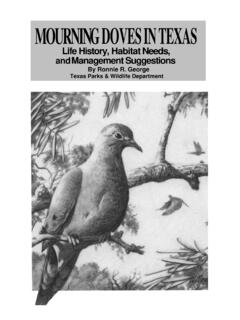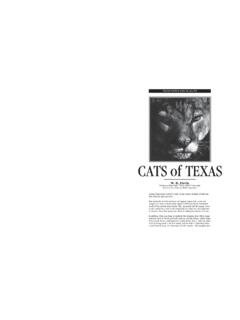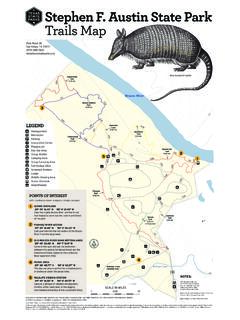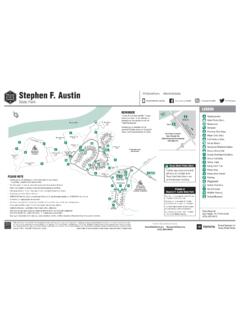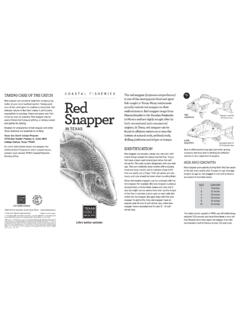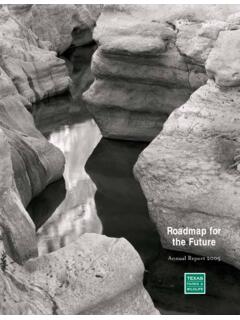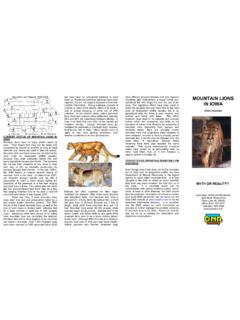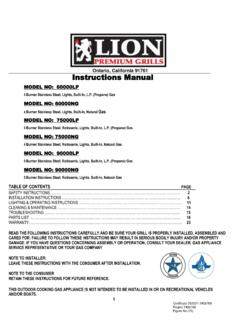Transcription of A Field Guide to Texas Mountain Lions
1 Texas PARKS AND WILDLIFEBy billy pat mckinneyA Field Guide Totexas Mountain lionsacknowledgementsI wish to thank Texas Parks and Wildlife Department employees BobCook, Bob West, Ron George, Matt Wagner, Jack Kilpatric, Bill Russ,Mike Pittman, Tim Bone, Ruben Cantu, Georg Zappler and DavidRiskind for their assistance and review of this manuscript. Thanks arealso due Jimmy Rutledge, TPWD, for his contribution on the biologyof the Mountain lion and to Bonnie R. McKinney, TPWD, for thetime and work she contributed to this of contentsIntroduction ..1 Mountain Lion Biology ..2 Behavioral Classes ..4 Aging ..5 Tracks.
2 9 Traveling Patterns ..12 Scrapes ..12 Scats ..13 Kills ..15 Wildlife Predation ..17 Livestock Depredation ..17 Nuisance Lions ..18 Lion and Human Interaction ..21 Who to Call ..inside back coverSuggested Reading ..inside back coverRock art depicting large cat and shaman (medicine man) from Panther Cave, SeminoleCanyon State Park, Texas . Illustration by Nola Mountain lion (Puma concolor), also known as cougar, puma and panther, hasbeen an integral part of the Texas fauna for thousands of years, as evidenced by thepaintings and pictographs of Native Americans (see left) and the fossil were once common throughout Texas , but since Anglo settlement, they havemostly been confined to isolated and rugged areas of the state.
3 Lions now appear tobe moving back into historic habitats where they have not been documented forwell over a hundred years. It is increasingly more important for range and wildlifemanagers to be able to recognize lion sign, in order to monitor populations in agiven area. Lions are solitary, secretive creatures. This Guide attempts to providefield people with a working knowledge of the Mountain lion. It is not intended forthe experts, but rather for laypersons in order to provide them with the basics oflion behavior, allowing them to interpret the traces left by the Lions are controversial animals that often evoke love-hate feelings onthe part of humans.
4 Whatever one s perspective, however, Mountain Lions are fascinating and little understood animals that play an important role in the Texasecosystem. The Mountain lion is adaptable and can be found thriving in hotdeserts, wetlands and high mountains. The challenge for resource managers is todevelop a management plan for the lion that will address the concerns of bothwildlife and livestock, and that will insure that the lion continues to be an important part of our Texas Field Guide to Texas Mountain lions1 Mountain LION BIOLOGYThe Mountain lion s scientific name, Puma concolor, means cat of one color (Figure1). Mountain Lions are also called pumas, cougars and panthers.
5 They occur inhabitats ranging from the southern tip of South America to northern BritishColumbia, Canada. The subspecies found in Texas is stanleyana. Historical datadocuments the existence of Lions in every ecological region in Lions are reddish brown to tawny in color. From the tip of the nose tothe tip of the tail, males can measure in excess of 7 feet, with females being some-what smaller. Normal weight in adult males averages 100-150 pounds, and 55-90pounds in adult females. In the wild, longevity ranges between 10 and 11 years; incaptivity, Mountain Lions have been known to live much Lions are solitary animals.
6 They are active crepuscularly (mornings andevenings) as well as nocturnally (night). Adult males and females are only togetherfor a 3-to-5-day period during breeding. Lions may breed at any time during theyear, but most litters are born in the summer and fall. Females first breed whenthey are around 2 years of age. Intervals between litters average from 18 months to2 years. Average litter size is normally 2 to 3 young with as many as 6 young beingreported. The gestation period is about 90 days. Female Lions pick locations withintheir home range that offer cover and security for their young. Kittens may be lefta Field Guide to Texas Mountain lions2 Fig.
7 1. Puma concolor. Photo by Billy Pat for hours at a time while the mother hunts to feed them. Females mayleave their kittens in heavy brush, rockslides, caves or overhangs (Figure 2). Thegrowing cubs stay with the female until they are 11 to 24 months of age, at whichtime they disperse and begin looking for their own range. Dispersal of young lionsdepends on the distance to unoccupied habitat. Recent research has documenteddispersal distance up to 300 air miles from natal (birth) areas. Generally, sub-adultmales disperse further than females. The size of a lion s home range is determined by a variety of factors: prey abun-dance and availability, topography and other habitat features, and presence of otherlions.
8 Male home ranges average 2-1/2 times larger than those of females. Themale s range usually encompasses the range of several females. Research has shownsome overlap in home ranges of adult males, but normally males do not shareranges. The home range of an adult male may vary from 80 to 200 square miles,while female ranges are normally 20 to 100 square miles. Female ranges tend tohave some degree of overlap with those of other females, although they Field Guide to Texas Mountain lions3 Fig. 2. Typical den sight. Photo by Billy Pat Texas , Mountain Lions primarily prey on white-tailed deer (Odocoileusvirginianus) and desert mule deer (Odocoileus hemionus crooki).
9 Various estimateshave been made concerning how often a lion kills a deer, ranging from every 3 to 5 days, for a female raising cubs, to every 5 to 14 days for adult males. Some vari-ability may be attributed to climatic conditions. During hot weather, the kill spoilsquickly, making it necessary for the lion to kill more often to obtain fresh meat. Incooler weather, the kill lasts longer, which decreases the frequency of on the abundance and availability of alternative prey items within aparticular habitat, Lions also prey on javelina (Tayassu tajacu), porcupine (Erethizondorsatum), skunks (Mephitisspp. and Spilogalespp.)
10 , other small game and CLASSESIn order to make competent observations, the Field observer should be aware ofthree behavioral classes of Lions . These categories are extremely important wheninterpreting lion population A transientis a lion without a home range. This can be a young dispersal-ageindividual or an older lion that has been displaced. Lions of this class will travelmany miles to establish a suitable new range. Young dispersal-age Lions needsufficient space in order for them to coexist with other Lions . Young Lions willsometimes fill a range previously occupied by a resident lion that has died orrelocated.
